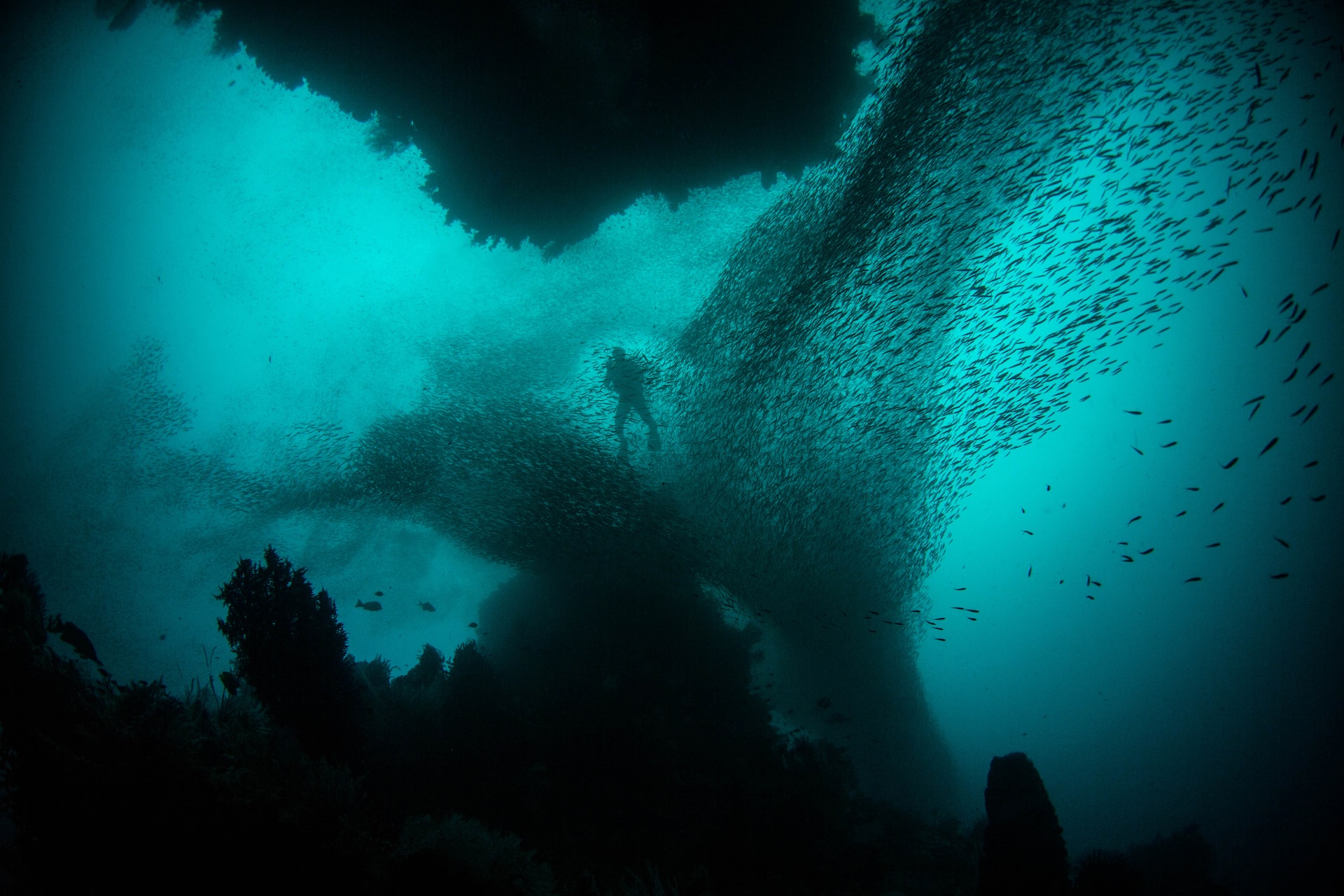
How Deep Is the Ocean Floor? Exploring the Abyssal Plain
We are reader-supported. When you buy through links on our site, we may earn affiliate commission.
Few places on Earth are as mysterious as the deep blue sea. Also known as the “abyssal plain,” the black and quiet trenches below the crest remind us we’ve barely scratched the surface of ocean exploration. But how deep is the ocean floor and what lives there?
The numbers are mind-boggling — as are the brightly-glowing and somewhat monstrous organisms dwelling in the dark.
How Deep Is the Ocean?
The Challenger Deep lies along the southern part of the Mariana Trench at a recently revised depth of 35,876 feet in the Pacific Ocean. This is nearly three times the ocean’s average depth of 12,100 ft and over 6,000 ft deeper than Mt. Everest is upside down.
The Challenger Deep was named for the HMS Challenger — a British Navy warship-turned-oceanographic-explorer whose crew first sounded the Mariana Trench in 1875.
The ocean remains one of the most fascinating places on Earth, symbolizing adventure and new beginnings in uncharted waters. Yet, although we have learned the ocean covers 71% of the planet, humans have only explored 5%. We can try to fathom its immensity, but we can never comprehend how expansive it truly is.
Can Humans Swim in the Challenger Deep?
The Challenger Deep has a pressure of 15,700 pounds per square inch — equivalent to about 100 adult elephants standing on you. For perspective, recreational divers can safely swim at depths of 130 ft with 72 psi. Conversely, professional divers may explore 330 ft or more with the appropriate equipment and training.
Because of the pressure, few people have ventured to the bottom of the Challenger Deep. Until 2019, Don Walsh, Jacques Piccard and James Cameron were the only individuals fortunate to see it in person.
As of 2019, the Limiting Factor deep-submergence vehicle has paved the way for safer deep-sea ocean exploration. The Limiting Factor is currently the only DSV capable of withstanding the Challenger Deep. Its 90-millimeter-thick pressure hull is its defining feature, allowing it to reach 36,000 ft and endure 14,000 meters of pressure — just about 19,880 psi.
Diving too deep could severely impact your lungs, restrict circulation and cause your heart to enlarge. In the Challenger Deep, the pressure is enough to crush you, causing severe injury, brain damage and death.
Unfortunately, the world watched in horror as this happened in June 2023 — when the Titan submersible imploded during a trek to the Titanic’s remains at 12,500 ft below sea level. The pressure is roughly 6,000 psi at those depths. Experts say an immediate implosion would have occurred in less than 40 milliseconds.
2016 Deepwater Exploration
The 2016 Deepwater Exploration of the Marianas was the first scientific expedition in the Mariana Trench. The expedition lasted 59 days while crews controlled remote operating vehicles, mapping technologies and electronic instruments called CTD rosettes to measure conductivity, temperature and depths.
Throughout the expedition, scientists uncovered biodiversity hotspots, various bottom fish species and insights for improving the management and conservation of the Mariana Trench.
Even the deepest parts of the ocean are susceptible to pollution. Ocean explorer Victor Vescovo discovered a plastic bag at 35,849 feet in 2019.
5 Creatures in the Abyssal Plain
Thousands of species — some of which are bioluminescent — consider the abyssal plain their home. Consider the environment these species thrive in — where light cannot penetrate and silence all around. Surviving at these depths requires unique characteristics and biological functions.
You may not recognize most deep-sea fish and organisms as they stay hidden in darkness. Meanwhile, some look exactly what nightmares are made of. Here are five species you might encounter on an expedition in the deep blue sea.
1. Dumbo Octopus
You can find the dumbo octopus at 13,100 feet below the surface — deeper than any other known octopus. The dumbo octopus’s name comes from its fins resembling elephant ears.
Although there are 15 species of dumbo octopuses, they are an anomaly — a reason they have unique capabilities of finding mates and reproducing. The species also can withstand frigid temperatures.
2. Black Seadevils
You don’t want to cross paths with the black seadevil anglerfish in the dark. Perhaps most recognizable by their razor-sharp teeth, these deep-sea fish are known for their predatory behaviors.
Black seadevils have a rod-like illicium on their heads — a type of growth with a bioluminescent esca. They use the esca to attract prey in the darkest parts of the Challenger Deep. The teeth can even expand if their dinner is larger.
Deep-sea exploration has enabled scientists to learn more about the elusive black seadevil. Since 2014, researchers have identified 168 species of anglerfish, even discovering their bioluminescent esca shines in different colors like yellow, blue and orange.
3. Goblin Shark
The goblin shark is of the most bizarre-looking shark species, swimming at depths up to 4,000 feet in the Pacific, Indian and Atlantic oceans. You might notice their long snout and pinkish hue when you first see them.
Male goblin sharks measure around 8.7 feet, while females can reach up to 11 feet. However, they typically won’t grow longer than 16.4 feet.
4. Mariana Snailfish
In August 2022, the Mariana snailfish broke records when scientists discovered it swimming at 26,319 feet below the surface near the Japan Trench. The occurrence marked the first time any fish were seen below 26,247 feet.
Snailfish have proven difficult for scientists to study. Having adapted to freezing temperatures at the farthest depths of the ocean, those brought to the surface have succumbed to atmospheric pressure and heat. Some researchers say they “melt” or “explode,” so biologists study their skeletons to understand more about them instead.
5. Vampire Squid
The vampire squid is another frightening-looking creature of the Challenger Deep. However, many refer to them as “gentle scavengers.”
Oddly, vampire squids aren’t actually squids. The species was misclassified in 1903 until scientists realized it wasn’t an octopus or squid in the 1950s.
True to its name, though, the vampire squid has two delicate tentacles — much like vampire fangs — which extend to nearly eight times its size. The tentacles’ hairs stimulate nerves, allowing the squid to sense its surroundings and find food.
There’s Much Left to Explore in the Ocean
As technology advances and humans find more ways to explore the abyssal plain, we are likely to discover more unique species. Ocean depths may have hindered our ability to witness the wonders of the deep sea, but current submersibles and mapping tools have profoundly impacted ocean discoveries. Imagine what we can learn in the coming decade.
Share on
Like what you read? Join other Environment.co readers!
Get the latest updates on our planet by subscribing to the Environment.co newsletter!
About the author
Steve Russell
Steve is the Managing Editor of Environment.co and regularly contributes articles related to wildlife, biodiversity, and recycling. His passions include wildlife photography and bird watching.





